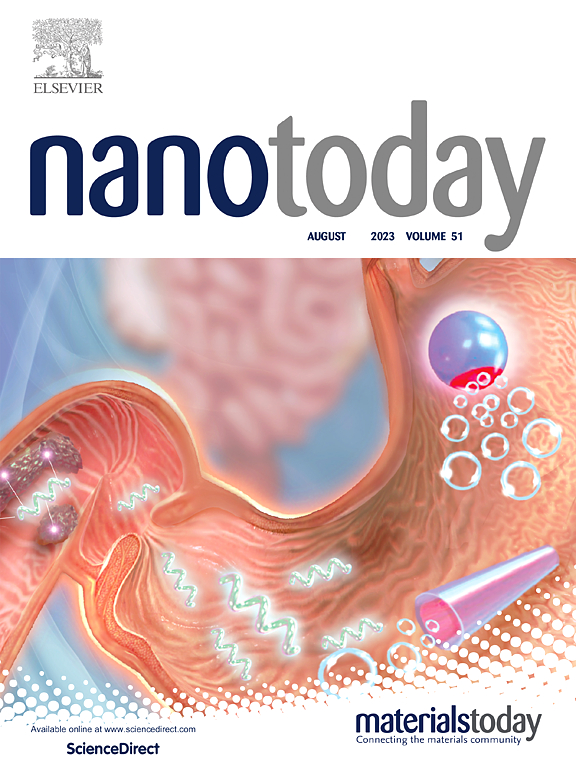微环境触发氧化铜和单宁酸协同铁配位纳米复合材料用于肝癌氧化应激增强放疗
IF 10.9
1区 材料科学
Q1 CHEMISTRY, MULTIDISCIPLINARY
引用次数: 0
摘要
肝细胞癌(HCC)是最常见和最具侵袭性的肝癌之一,治疗选择有限,预后差。常规放射治疗(RT)的有效性经常受到肿瘤细胞抵抗和周围健康组织损伤的阻碍。为了解决这一挑战,本研究引入了一种新的过氧化氢(H2O2)自供应过氧化铜(CuO2)-铁单宁酸(Fe-TA)纳米复合材料,旨在提高氧化应激增强RT治疗HCC的疗效。CuO2纳米颗粒(CP)组分作为H2O2自供平台,在酸性肿瘤微环境(TME)中释放H2O2和Cu2+,通过芬顿样反应内源性生成羟基自由基(•OH)。此外,从这种纳米复合材料中释放的铁离子增强了芬顿催化作用,从而减少了对铜基纳米材料的依赖。铁离子还有助于磁共振成像(MR)指导rt。一系列体外和体内实验表明,CuO2@Fe-TA纳米复合材料(CPF)在TME和x射线照射激活下可以控制和选择性地抑制肿瘤生长。综合毒性评价表明制备的CPF具有良好的生物相容性和安全性。本研究为HCC的肝脏RT提供了一种临床可行的增敏剂,并为其他类型癌症的治疗提供了潜在的启示。本文章由计算机程序翻译,如有差异,请以英文原文为准。
Microenvironment-triggered copper peroxide and tannic acid cooperatively iron-coordinated nanocomposites for oxidative stress-enhanced radiotherapy of hepatocellular carcinoma
Hepatocellular carcinoma (HCC) is one of the most common and aggressive forms of liver cancer, with limited treatment options and poor prognosis. The effectiveness of conventional radiotherapy (RT) is often hindered by tumor cell resistance and damage to surrounding healthy tissues. To address this challenge, this study introduces a novel hydrogen peroxide (H2O2) self-supplying copper peroxide (CuO2)-iron-tannic acid (Fe-TA) nanocomposite aiming to enhance the efficacy of oxidative stress-enhanced RT for HCC. The CuO2 nanoparticles (CP) component functions as an H2O2 self-supplying platform, releasing H2O2 and Cu2+ in the acidic tumor microenvironment (TME), thereby generating hydroxyl radicals (•OH) endogenously through Fenton-like reactions. Additionally, the iron ions released from this nanocomposite amplify Fenton catalysis, thus reducing reliance solely on copper-based nanomaterials. The iron ions also facilitate magnetic resonance (MR) imaging to guide RT. A series of in vitro and in vivo experiments demonstrate that the CuO2@Fe-TA nanocomposites (CPF) can controllably and selectively inhibit tumor growth when activated by the TME and X-ray irradiation. Moreover, comprehensive toxicity assessments confirm that the prepared CPF exhibit good biocompatibility and safety. This research offers a clinically viable sensitizer for liver RT of HCC and suggests potential implications for the treatment of other cancer types.
求助全文
通过发布文献求助,成功后即可免费获取论文全文。
去求助
来源期刊

Nano Today
工程技术-材料科学:综合
CiteScore
21.50
自引率
3.40%
发文量
305
审稿时长
40 days
期刊介绍:
Nano Today is a journal dedicated to publishing influential and innovative work in the field of nanoscience and technology. It covers a wide range of subject areas including biomaterials, materials chemistry, materials science, chemistry, bioengineering, biochemistry, genetics and molecular biology, engineering, and nanotechnology. The journal considers articles that inform readers about the latest research, breakthroughs, and topical issues in these fields. It provides comprehensive coverage through a mixture of peer-reviewed articles, research news, and information on key developments. Nano Today is abstracted and indexed in Science Citation Index, Ei Compendex, Embase, Scopus, and INSPEC.
 求助内容:
求助内容: 应助结果提醒方式:
应助结果提醒方式:


